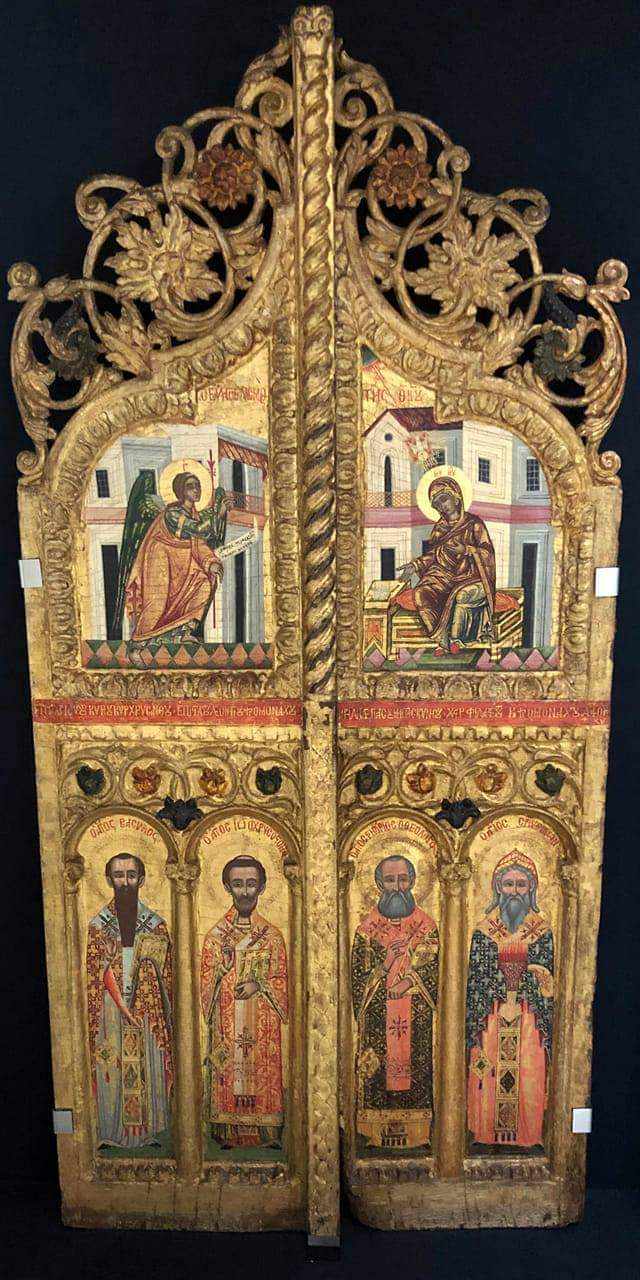Wednesday 25/08/2021
The pulpits of the church of Agios Anastasios
In Cyprus from Japan - A complicated case of repatriation
ONE OF THE MOST COMPLEX REPATRIATION CASESIS CONCLUDED
The Department of Antiquities, Ministry of Transport, Communications and Works announces that the Royal iconostasis doors of the church of Agios Anastasios in the occupied Peristeronopigi village, Famagusta District, have been repatriated from Japan.
The Royal iconostasis doors have returned to Cyprus after yearlong efforts that have been intensified during the last two years, thus concluding one of the most renowned and at the same time complex cases of repatriation. The looting of the church of Agios Anastasios by the Turkish occupation army and its collaborators and the sale of the Royal iconostasis doors, as well as of the icons and sacred vessels of the church, the fate of which remains unknown, reveals once again the catastrophic consequences of the Turkish invasion on the cultural heritage of Cyprus.
The Royal iconostasis doors were located in Japan in the 1990s at the Kanazawa College of Art. Their repatriation was made possible following the coordinated efforts of the Department of Antiquities of Cyprus, the Embassy of the Republic of Cyprus in Tokyo and the Church of Cyprus, together with the competent authorities of the Kanazawa College of Art that possessed the Royal iconostasis doors.
The Royal iconostasis doors from Agios Anastasios church belong to the Cypriot iconographic tradition of the 18th century, which is differentiated from the rest of the Orthodox world, of which they are an important example. During this period, the upper part of iconostasis doors were usually decorated with representations of the Annunciation, while the lower parts were often decorated with representations of the Three Hierarchs and occasionally, with a Cypriot saint, Agios Spyridonas in this case. Apart from their archaeological importance, Royal iconostasis doors bear important symbolical and religious meanings, since they are an integral part of Orthodox churches. The repatriated Royal iconostasis doors from Peristeropigi date to 1778, according to an inscription preserved between the upper part representing the Annunciation and the lower part representing the Three Hierarchs and Agios Spyridon. According to the inscription, the Royal iconostasis doors were painted by the Monk Filaretos from Psimolofou, who became Protosyncellus in the Monastery of Agios Iraklidios in Politiko, an important iconographic center of that period. The doors were made at the expense of Hatzigiasoumis, probably a resident of Peristeronopigi village, during the time when Chrysanthos was Archbishop and Leontios was Abbot (Egoumenos) («Επ’ ἀρχιθύτου Κυρίου Κυρ Χρυσάνθου, ἑπιστάτου Λεόντιου ἱερομονάχου, δαπάνῃ δε Γιασουμῆ προσκυνητοῦ. Χείρ Φιλαρέτου και ἱερομονάχου αψοή»).
The Department of Antiquities wishes to express its gratitude to the Church of Cyprus and especially to the Archbishop, with whom direct communication on the case occurred throughout the whole process and whose support and contribution towards the repatriation efforts was invaluable, to the competent Directorates of the Ministry of Foreign Affairs of the Republic of Cyprus for their close cooperation, the National Committee for Combating the Looting and Illegal Trafficking of Cultural Heritage, as well as all other governmental authorities of the Republic of Cyprus involved, such as the Department of Customs and Excise, the Department of Civil Aviation and the Cyprus Police, especially the Office for the Combating of Illicit Possession and Trafficking of Antiquities of the Police Headquarters, for facilitating the return of the Royal iconostasis doors to Cyprus.
The Department of Antiquities as the competent authority of the Republic of Cyprus for the protection and management of our cultural heritage, will continue all efforts for its preservation and protection. Although it is acknowledged that the fight against illicit trafficking is an extremely difficult and complex issue, the Department of Antiquities is confident that through coordinated efforts, the desired results can be reached.
The Royal iconostasis doors will be conserved by the Department of Antiquities and will be handed over to the Holy Archbishopric of Cyprus, until their return to the church of Agios Anastasios, where they belong, is made possible.
The Minister of Transport, Communications and Works wishes to thank especially the Director of the Department of Antiquities, as well as all those you contributed towards the success of this extremely important repatriation.
#Repatriation #SavingAntiquities

 English
English
 Ελληνικά
Ελληνικά Русский
Русский
 Posted by
Vasilis Zenonos
Posted by
Vasilis Zenonos






